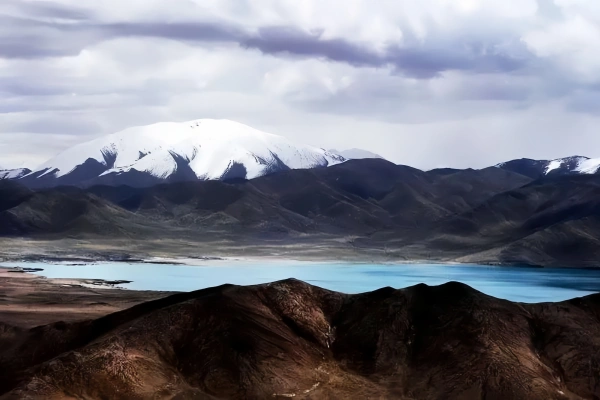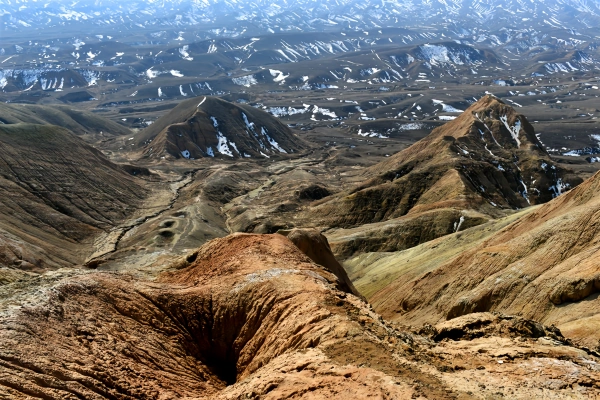Pulu Volcano
Historical Overview
The history of Pulu Volcano is etched in the very fabric of the land. It has been active for thousands of years, with its eruptions leaving behind a trail of geological evidence. In local folklore, the volcano is often associated with powerful deities and mythical creatures. Ancient tribes believed that the volcano was a gateway to the underworld or a place where the gods communicated with humans. Throughout history, the volcano has witnessed the rise and fall of civilizations in the area. Some cultures even built settlements near its base, taking advantage of the fertile soil created by volcanic ash. Over time, scientific research has shed light on the volcano's eruption patterns and helped in predicting potential future activities, making it both a natural wonder and a subject of scientific study.
Structural Layout
Pulu Volcano has a well - defined structural layout that is a result of its volcanic activity. At its core is the main crater, a large, bowl - shaped depression that serves as the volcano's "mouth." Surrounding the crater are steep slopes covered in volcanic rock and ash. These slopes are interspersed with lava tubes, which are natural tunnels formed by flowing lava. As you move away from the crater, you'll find a series of secondary cones and fissures. These secondary features were created during smaller eruptions and add to the volcano's complex topography. The base of the volcano is often surrounded by a plain of volcanic debris, including cinders, pumice, and solidified lava flows. There are also several observation points strategically located around the volcano, allowing visitors to get a good view of its different features.

Major Attractions
Main Crater: This is the heart of Pulu Volcano. Standing at the edge of the crater, you can feel the heat emanating from the depths below and hear the faint rumbling sounds that hint at the volcano's power. The view into the crater is a sight to behold, with colorful mineral deposits and steam vents creating a surreal landscape.
Lava Fields: The lava fields around Pulu Volcano are a testament to its past eruptions. These vast expanses of hardened lava are covered in unique patterns and textures. You can walk across the lava fields and explore the various shapes and formations created by the cooling lava. Some areas even have small caves and tunnels formed within the lava flows.
Volcanic Hot Springs: Nestled at the base of the volcano are several natural hot springs. These hot springs are heated by the volcanic activity below and offer a relaxing and therapeutic experience. Surrounded by lush vegetation, the hot springs provide a perfect place to unwind after a day of exploring the volcano.
Observation Decks: There are multiple observation decks located at different elevations around the volcano. From these decks, you can enjoy panoramic views of the entire volcanic landscape, including the crater, lava fields, and the surrounding mountains. On a clear day, you can even see for miles into the distance.
Suggested Itineraries
Half - Day Quick Tour (2 - 3 hours):
Start at the visitor center to get an overview of the volcano and pick up a map.
Head straight to the main observation deck to get a great view of the crater.
Take a short walk along the lava field trail to see some of the unique lava formations.
Finish your tour by visiting one of the nearby hot springs for a quick soak.
Highlights: Get a quick but comprehensive look at the main features of Pulu Volcano, including the crater, lava fields, and hot springs.
One - Day In - Depth Tour (5 - 7 hours):
Begin at the visitor center and attend a short presentation on the volcano's history and geology.
Hike up to the main crater, taking your time to appreciate the different volcanic features along the way.
Explore the lava fields in more detail, looking for interesting rock formations and small caves.
Have a picnic lunch near one of the hot springs.
After lunch, visit all the observation decks to get different perspectives of the volcano.
End your day with a relaxing soak in the hot springs.
Highlights: A more in - depth exploration of the volcano, allowing you to learn about its history, geology, and experience its natural beauty up close.
Two - Day Comprehensive Adventure:
Day 1:Arrive at the base of the volcano and check into a nearby accommodation.
Spend the afternoon visiting the visitor center and taking a short hike around the lower slopes of the volcano.
In the evening, enjoy a local dinner and learn about the volcano's significance in the local culture.
Day 2:Start early in the morning and hike to the main crater. Take your time to explore the crater and its surroundings.
After descending from the crater, spend the rest of the day exploring the lava fields and visiting all the observation decks.
End your adventure with a final soak in the hot springs and a reflection on your amazing experience.
Highlights: A relaxed and immersive experience, giving you enough time to fully appreciate the beauty and power of Pulu Volcano.
Ticket Purchase
Online: You can purchase tickets for Pulu Volcano through the official website of the local tourism board or popular online travel platforms. Online booking offers the convenience of choosing your preferred date and time of visit in advance. It also often comes with discounts, especially for group bookings or early bird purchases. Make sure to print out your tickets or have them ready on your mobile device for easy access at the entrance.
On - Site: Tickets are also available for purchase at the ticket office near the visitor center. However, during peak tourist seasons, there may be long queues, so it's advisable to arrive early. The staff at the ticket office can provide you with information about the different ticket options and any special offers available.
Prices: The ticket price for adults usually ranges from 15−25, depending on the season and any additional services included. There are discounts for students, seniors, and children. Family packages may also be available, offering savings for groups traveling together.

Transportation
By Bus: You can take a bus from the nearest major city to the town closest to Pulu Volcano. From there, you can transfer to a local shuttle bus that will take you directly to the visitor center. The bus journey offers a chance to see the local scenery and get a feel for the region.
By Taxi: If you prefer a more direct and convenient option, you can take a taxi from the city to the volcano. Make sure to negotiate the fare with the driver in advance and agree on a pick - up time for your return journey. Taxis provide flexibility in terms of departure and arrival times.
Self - driving: If you have your own vehicle, you can drive to Pulu Volcano. There is usually a well - marked parking area near the visitor center, providing easy access to the volcano's attractions. Self - driving allows you to explore the surrounding area at your own pace and make stops along the way.
Best Time & Tips
Best Time: The best time to visit Pulu Volcano is during the spring (March - May) and autumn (September - November). The weather during these seasons is mild and pleasant, with clear skies that offer great visibility of the volcanic features. Summers can be hot and humid, while winters may bring snow and cold temperatures, making hiking and exploration more challenging.
Peak Hours: Try to avoid visiting during the peak hours of 11 AM - 3 PM, as the volcano can get crowded with tourists. It's better to arrive early in the morning when the site opens or later in the afternoon to enjoy a more peaceful experience.
Essentials: Wear sturdy hiking boots as the terrain around the volcano can be rough and uneven. Bring sunscreen, a hat, and sunglasses to protect yourself from the sun, especially during the summer months. Carry plenty of water to stay hydrated, as there may not be many water sources available on the trails.
Photography: Photography is allowed at Pulu Volcano, and it offers countless opportunities to capture stunning images. However, be respectful of other visitors and avoid using flash photography inside any enclosed areas or near sensitive volcanic features. The golden hours of sunrise and sunset are particularly beautiful for taking photos of the volcano.
Prohibited Items: Drones are strictly prohibited around Pulu Volcano due to safety and privacy concerns. Large backpacks and camping equipment may also be restricted in certain areas. Check the park's regulations in advance to ensure a smooth visit.
Contact Us
What Our Clients Say?
Based on 10,000+ traveler reviews













